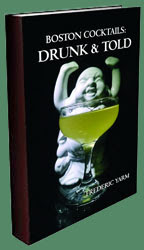
The theme for this month's
Mixology Monday (MxMo LII) was picked by Dennis of the
Rock & Rye blog. He chose the theme of "Forgotten Cocktails," but unlike Ted Haigh's book, Dennis does not care what decade in which the drink originated or was forgotten. He described the concept as, "bring[ing] to light a drink that you think deserves to be resurrected from the past, and placed back into the spotlight. It could be pre-Prohibition, post-war, that horrible decade known as the 80's, it doesn't really matter. As long as it is somewhat obscure, post it up."
About two weeks ago, Andrea and I attended a Boston launch party for Galliano Ristretto coffee flavored liqueur. That night was also National Harvey Wallbanger Day, so they were honoring Galliano L'Autentico (a recent return to the original recipe) as well. Andrea and I fondly remembered a Galliano drink we had on Christmas eve last year. We were sitting at the bar at Eastern Standard and watching bartender Hugh Fiore churn out drink after drink at the service end of the bar for the rather thirsty patrons on the restaurant floor. When we saw him making a drink using Galliano, we asked what it was. Hugh mentioned that it was the Golden Cadillac that bar manager Jackson Cannon had just put on the dessert section of the menu. We were a bit skeptical of the drink, but Hugh declared that it was rather good and that he would make a little extra next time so we could have a taste.
When I mentioned this Mixology Monday theme, it was not long before the idea of the Golden Cadillac as a forgotten cocktail arose. And considering that we were gifted a bottle of Galliano L'Autentico at the event to replace our pre-2009 formulation, it seemed like a good idea. Gary Regan in
The Joy of Mixology placed the drink's creation sometime during the sixties or seventies at Poor Red's Bar-B-Q in El Dorado, California. Whether the drink was named after El Dorado being in the heart of the old California gold rush, the color of Galliano itself, the Eldorado Cadillac car, or the 1956 movie
The Solid Gold Cadillac, I am not certain (*). But I am certain that Poor Red's makes so many of these drinks to this day that they are Galliano's largest account in this country. Definitely, the drink is not forgotten in El Dorado, but to the rest of the world, the drink has sort of slipped away to the realm of the Pink Squirrel and the like.
The ingredients of the drink are the trinity of Galliano, crème de cacao, and cream. You might think this is an absurd combination until you realize that it is essentially an Alexander sans a nutmeg garnish, except here the spirit is Galliano instead of the classic gin or more traditional brandy. Moreover, similar nonstandard spirits have been utilized in Alexanders including my
Fernet and Bobby Heugel's Campari ones. The proportions vary from Gary Regan's crème de cacao heavy one to Stan Jones' cream-laden one, but I will stick to the one I first tasted at Eastern Standard which is an equal parts recipe:
Golden Cadillac
• 1 oz Galliano
• 1 oz Clear Crème de Cacao
• 1 oz Cream
Shake with ice and strain into a cocktail glass. Poor Red's apparently prefers to serve theirs in a coupe glass.
With the new reformulation of Galliano (which approximates the original), this drink was rather tasty. Vanilla and chocolate notes helped to modify the sarsaparilla flavor on the swallow. Unlike the previous incarnation, the current Galliano is light on the licorice note, so it was rather absent in the drink's flavor profile. Andrea commented that despite the vanilla on the nose, the drink tasted a bit like a good root beer soda. The cream seemed to sooth the Galliano and shape the drink into something surprisingly elegant.

Cheers to Dennis for hosting this month's Mixology Monday and to Paul Clarke for organizing the shindig month after month!
(*) The
American Bartending School video poetically told me that it was called the Golden Cadillac for Galliano is yellow and "quite expensive" like a Cadillac. Sadly in the video, the host does not drop a bottle or anything
intriguing like his other ones save for spilling some of the ingredients on the bar top.










 The theme for this month's
The theme for this month's 



















 2 oz Banks Rum
2 oz Banks Rum



 The 2017 collection of 855 drink recipes, bartender tributes, and essays on hospitality from CocktailVirgin's Frederic Yarm. Available at
The 2017 collection of 855 drink recipes, bartender tributes, and essays on hospitality from CocktailVirgin's Frederic Yarm. Available at  The 2012 collection of 505 drink recipes, techniques, and Boston bar recommendations from Frederic Yarm. Available at
The 2012 collection of 505 drink recipes, techniques, and Boston bar recommendations from Frederic Yarm. Available at 



